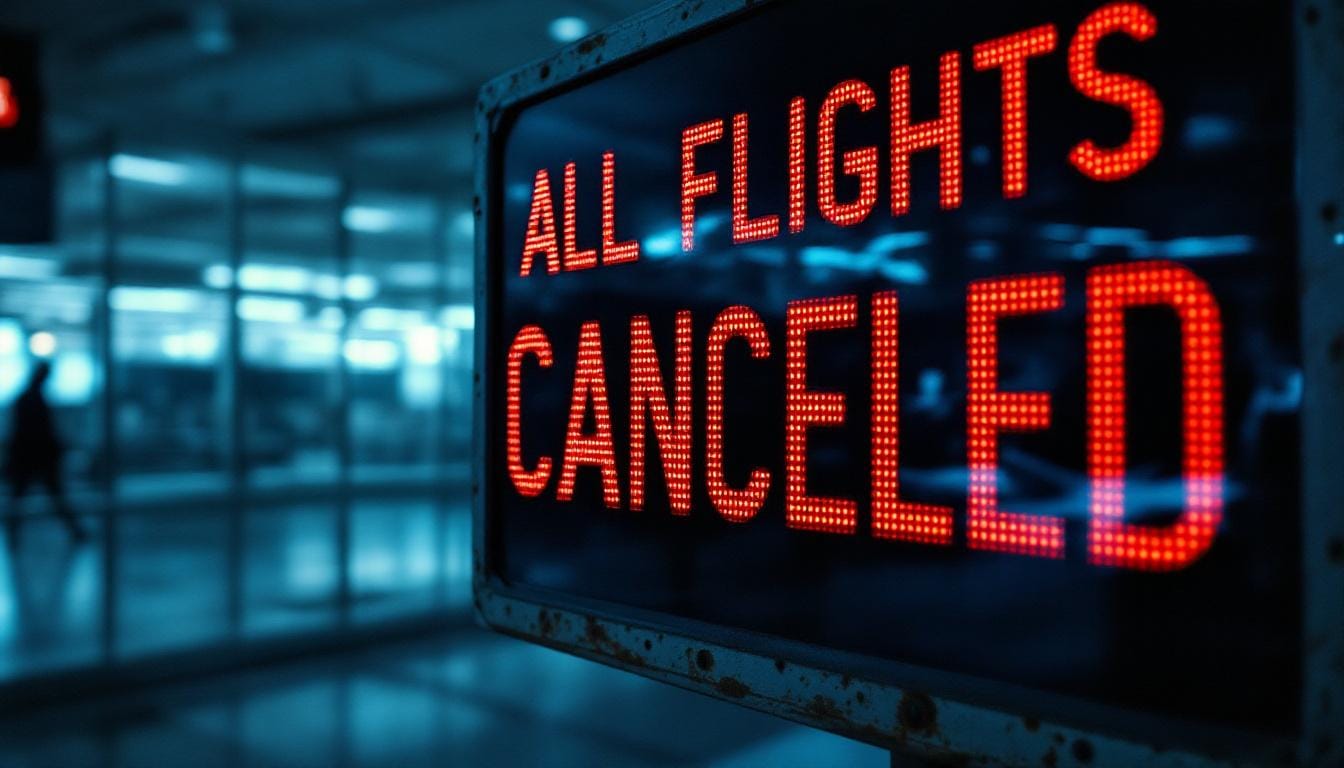Why Flights Stay Grounded Even After the Shutdown Ends
Because political deadlines end fast, but rebuilding a safe, fully staffed air-traffic network takes weeks.

As President Trump took to social media Monday demanding air traffic controllers get “back to work, NOW!!!” and proposing $10,000 bonuses [1] airlines scrapped over 2,300 flights.[2] The stark contrast between political rhetoric and operational reality defines the ongoing travel chaos, proving that a signed funding bill doesn’t instantly fix a fractured system.
Despite the government shutdown ending, the Federal Aviation Administration (FAA) is holding firm on its order for airlines to cut up to 10% of flights from 40 major U.S. airports.[3]
The reason? A crippling cascade of absences and overwhelming stress among the air traffic controllers who went unpaid for over a month,[4] a public safety crisis that no legislative pen stroke can immediately resolve.
A System Running on Empty
The core of the delay isn’t just bureaucratic procedure, it’s human endurance. Unpaid for more than 30 days, many controllers reached a breaking point, calling out due to stress or the urgent need to work second jobs, creating critical staffing shortfalls. [5]
The FAA’s initial 4% reduction target last week ballooned to 6% Tuesday and is slated to hit 10% by Friday,[6] a clear indicator of a system under severe duress.
The situation grew so dire that the FAA expanded restrictions beyond commercial airlines, blocking business jets and private flights from a dozen already strained airports to further ease the burden on overwhelmed controllers.[7]
A Long Road to Recovery
Transportation Secretary Sean Duffy made it clear last week that the flight cuts would remain long after the shutdown concluded, stating they would stay until staffing at air traffic control centers fully stabilizes.[8]
Major airlines, which have already canceled over 7,900 flights since Friday,[9] support this cautious approach.
They confirm that even with restrictions lifted, a return to normal schedules is impossible overnight.[10]
Aircraft and crews have been strategically repositioned or redeployed, and rebuilding a reliable, safe flight roster requires meticulous, time-consuming coordination.
What’s Next for Travelers?
Passengers should brace for a rocky transition period lasting days, if not weeks.
The airports affected, see list below, will continue to experience a heightened rate of cancellations and delays. Travelers are advised to check their flight status continuously and contact airlines directly for rebooking options.
The takeaway is simple.
While the political crisis in Washington may be over, the operational crisis in the skies is still climbing to its cruising altitude. The nation’s air traffic system is recovering from a month on life support, and it won’t be cleared for takeoff anytime soon.
The Complete List of 40 Airports Affected by FAA Flight Reductions
The FAA ordered domestic airlines to reduce schedules by 4% to 10% at the following airports to alleviate strain on understaffed air traffic control facilities[1][2][3]:
- Hartsfield-Jackson Atlanta International Airport (ATL) - Atlanta, GA
- Baltimore/Washington International Thurgood Marshall Airport (BWI) - Baltimore, MD
- Ronald Reagan Washington National Airport (DCA) - Arlington, VA
- Washington Dulles International Airport (IAD) - Dulles, VA
- Newark Liberty International Airport (EWR) - Newark, NJ
- John F. Kennedy International Airport (JFK) - New York, NY
- LaGuardia Airport (LGA) - New York, NY
- Philadelphia International Airport (PHL) - Philadelphia, PA
- Boston Logan International Airport (BOS) - Boston, MA
- Charlotte Douglas International Airport (CLT) - Charlotte, NC
- Chicago O'Hare International Airport (ORD) - Chicago, IL
- Chicago Midway International Airport (MDW) - Chicago, IL
- Cleveland Hopkins International Airport (CLE) - Cleveland, OH
- Detroit Metropolitan Airport (DTW) - Detroit, MI
- Indianapolis International Airport (IND) - Indianapolis, IN
- Minneapolis-Saint Paul International Airport (MSP) - Minneapolis, MN
- Pittsburgh International Airport (PIT) - Pittsburgh, PA
- Fort Lauderdale-Hollywood International Airport (FLL) - Fort Lauderdale, FL
- Miami International Airport (MIA) - Miami, FL
- Orlando International Airport (MCO) - Orlando, FL
- Tampa International Airport (TPA) - Tampa, FL
- Louis Armstrong New Orleans International Airport (MSY) - New Orleans, LA
- Dallas Fort Worth International Airport (DFW) - Dallas/Fort Worth, TX
- William P. Hobby Airport (HOU) - Houston, TX
- George Bush Intercontinental Airport (IAH) - Houston, TX
- San Antonio International Airport (SAT) - San Antonio, TX
- Austin-Bergstrom International Airport (AUS) - Austin, TX
- Nashville International Airport (BNA) - Nashville, TN
- Memphis International Airport (MEM) - Memphis, TN
- Kansas City International Airport (MCI) - Kansas City, MO
- St. Louis Lambert International Airport (STL) - St. Louis, MO
- Denver International Airport (DEN) - Denver, CO
- Salt Lake City International Airport (SLC) - Salt Lake City, UT
- Phoenix Sky Harbor International Airport (PHX) - Phoenix, AZ
- Las Vegas Harry Reid International Airport (LAS) - Las Vegas, NV
- Los Angeles International Airport (LAX) - Los Angeles, CA
- San Diego International Airport (SAN) - San Diego, CA
- San Francisco International Airport (SFO) - San Francisco, CA
- San Jose Mineta International Airport (SJC) - San Jose, CA
- Seattle-Tacoma International Airport (SEA) - Seattle, WA
Source Verification:
- FAA Newsroom - Official Statement on Airport Reduction List (The FAA's official release detailing the airports subject to its emergency order.) ↩︎
- CNN Travel - "FAA orders flight cuts at these 40 airports" (Journalistic report corroborating the full list of 40 airports.) ↩︎
- The Daily Reporter - "FAA reducing air traffic across 40 markets" (Additional source for the list of affected airports.) ↩︎
FOOTNOTES & SOURCES
- Politico: "Trump offers $10K bonus to air traffic controllers who show up to work" - Reports on President Trump's social media post and bonus proposal. ↩︎
- CNBC: "Flight cancellation totals for Monday and Tuesday" - Provides specific data on the number of flights canceled. ↩︎
- FAA Newsroom: "General Statements on Operational Orders" - The FAA's official statement on the 10% reduction mandate and affected airports. ↩︎
- The Washington Post: "Unpaid controllers cite stress, second jobs for absences" - Details the human impact of the shutdown on air traffic control staff. ↩︎
- Associated Press: "Controller absenteeism creates safety risk" - Covers the FAA's stated safety concerns due to staff shortages. ↩︎
- Fortune: "Timeline of escalating FAA flight cuts" - Outlines the progression from 4% to 10% reductions. ↩︎
- ViewFromTheWing: "FAA expands order to include business jets" - Reports on the extension of restrictions to general aviation. ↩︎
- The New York Times: "Duffy says cuts will persist post-shutdown" - Quotes the Transportation Secretary on the phased return to normal operations. ↩︎
- NBC News: "Cumulative flight cancellation totals" - Provides the figure of 7,900+ cancellations since Friday. ↩︎
- Airlines for America Statement (via CBS News Live Updates) - Notes airline support for a phased restart and operational challenges. ↩︎



